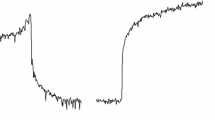Summary
In vitro the pressure-volume curves of small segments of the rat tail artery containing 75% smooth muscle were determined in the frequency range 0.018–25 Hz. The segments were held at in-situ lengths of about 6 mm. The vascular smooth tone muscle was influenced by treatment with norepinephrine and papaverine. The circumferential stressσ t was changed by varying the mean transmural pressure. The circumferential elastic modulusE t was calculated from values obtained by the static and dynamic pressure-diameter relations. The formula used is valid for thick-walled, longitudinally constrained vessels and is derived in a theoretical paragraph.
Results and conclusions:
-
1.
The quasistatic circumferential elastic modulus is 105 dynes/cm2 for the smallest stresses considered and increases to 2×106 dynes/cm2, occuring at maximum stress. These values are smaller by a factor of ten than those measured by other authors on large arteries.
-
2.
There is a linear relationship betweenE t andσ t at each frequency range investigated. The moduli observed after treatment with papaverine aregreater than those observed after excitation of the smooth muscle with norepinephrine, the same stress applying in each case.
-
3.
The dynamic elastic modulusE d (real part ofE t ) and the loss modulusω η w (imaginary part ofE t ) are related toσ t and plotted against frequency.E d /σ t increases slightly with frequency; this quotient is far smaller after treatment with norepinephrine than after the application of papaverine. The expressionω η w /σ t shows the well-known frequency dependence and proves to be independent of the smooth muscle tone. Therefore, when the smooth muscle is activated, the relative contribution of the loss modulus to the circumferential elastic modulus is greater than under conditions of relaxation.
Similar content being viewed by others
References
Apter, J. T., Marquez, E.: Correlation of visco-elastic properties of large arteries with microscopic structure. V. Effects of sinusoidal forcing at low and at resonance frequencies. Circulat. Res.22, 393–404 (1968).
Bader, H.: The anatomy and physiology of the vascular wall. In: Handbook of physiology, Sect. 2: Circulation, Vol. II, pp. 865–889. Washington: Amer. Physiol. Soc. 1963.
Bergel, D. H.: The dynamic elastic properties of the arterial wall. J. Physiol. (Lond.)156, 458–469 (1961).
Dobrin, P. B., Doyle, J. M.: Vascular smooth muscle and the anisotropy of dog carotid artery. Circulat. Res.27, 105–119 (1970).
—, Rovick, A. A.: Influence of vascular smooth muscle on contractile mechanics and elasticity of arteries. Amer. J. Physiol.217, 1644–1651 (1969).
Frank, O.: Die Analyse endlicher Dehnungen und die Elastizität des Kautschuks. Ann. Physik21, 602–608 (1906).
—: Die Elastizität der Blutgefäße. Z. Biol.71, 255–272 (1920).
Hardung, V.: Vergleichende Messungen der dynamischen Elastizität und Viskosität von Blutgefäßen, Kautschuk und synthetischen Elastomeren. Helv. physiol. pharmacol. Acta11, 194–211 (1953).
—: Dynamische Elastizität und innere Reibung muskulärer Blutgefäße bei verschiedener durch Dehnung und tonische Kontraktion hervorgerufener Wandspannung. Arch. Kreisl.-Forsch.61, 81–100 (1970).
Hinke, J. A. M., Wilson, M. L.: A study of elastic properties of a 550-μ arteryin vitro. Amer. J. Physiol.203, 1153–1160 (1962).
Kapal, E.: Die elastischen Eigenschaften der Aortenwand sowie des elastischen und kollagenen Bindegewebes bei frequenten zyklischen Beanspruchungen. Z. Biol.107, 347–404 (1954).
Kenner, Th.: Die Druck-Volumenkurve längsfixierter Arterien und die Bestimmung der Elastizitätsmoduln. Pflügers Arch. ges. Physiol.285, 211–221 (1965).
—: Neue Gesichtspunkte und Experimente zur Beschreibung und Messung der Arterienelastizität. Arch. Kreisl.-Forsch.54, 68–139 (1967).
Laszt, L.: Untersuchungen über die elastischen Eigenschaften der Blutgefäße im Ruhe- und im Kontraktionszustand. Angiologica5, 14–27 (1968).
Levasseur, J. E., Funk, F. G., Patterson, J. L.: Physiological pressure transducer for microhemocirculatory studies. J. appl. Physiol.27, 422–425 (1969).
McDonald, D. A.: Blood flow in arteries. London: E. Arnold 1960.
Patel, D. J., Janicki, J. S., Carew, T. E.: Static anisotropic elastic properties of the aorta in living dogs. Circulat. Res.25, 765–779 (1969).
—, Tucker, W. K., Janicki, J. S.: Dynamic elastic properties of the aorta in radial direction. J. appl. Physiol.28, 578–582 (1970).
Reichel, H., Vonderlage, M.: Der Einfluß steigender Arterenolkonzentration auf die Wandeigenschaften der Aorta. Verh. dtsch. Ges. Kreisl.-Forsch.35, 327–333 (1969).
Remington, J. W.: The physiology of the aorta and major arteries. In: Handbook of physiology, Sect. 2: Circulation, Vol. II pp. 799–838. Washington: Amer. Physiol. Soc. 1963.
Wetterer, E., Kenner, Th.: Grundlagen der Dynamik des Arterienpulses. Berlin-Heidelberg-New York: Springer 1968.
Wezler, K., Böger, A.: Die Dynamik des arteriellen Systems. Ergebn. Physiol.41, 291–606 (1939).
Author information
Authors and Affiliations
Rights and permissions
About this article
Cite this article
Bauer, R.D., Pasch, T. The quasistatic and dynamic circumferential elastic modulus of the rat tail artery studied at various wall stresses and tones of the vascular smooth muscle. Pflugers Arch. 330, 335–346 (1971). https://doi.org/10.1007/BF00588585
Received:
Issue Date:
DOI: https://doi.org/10.1007/BF00588585




